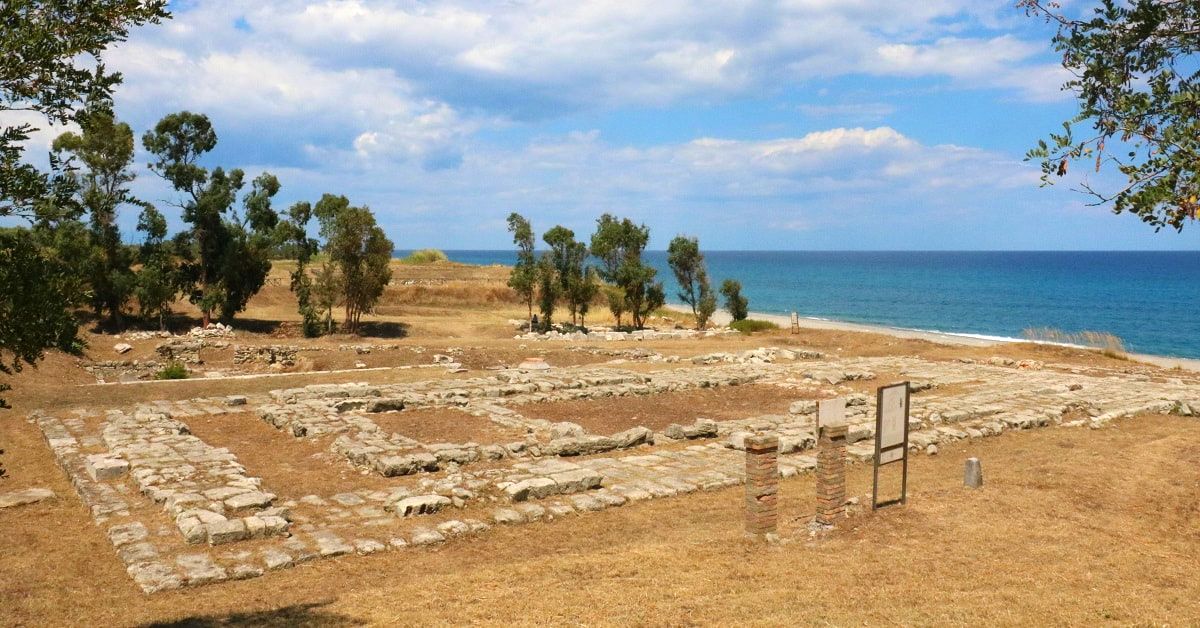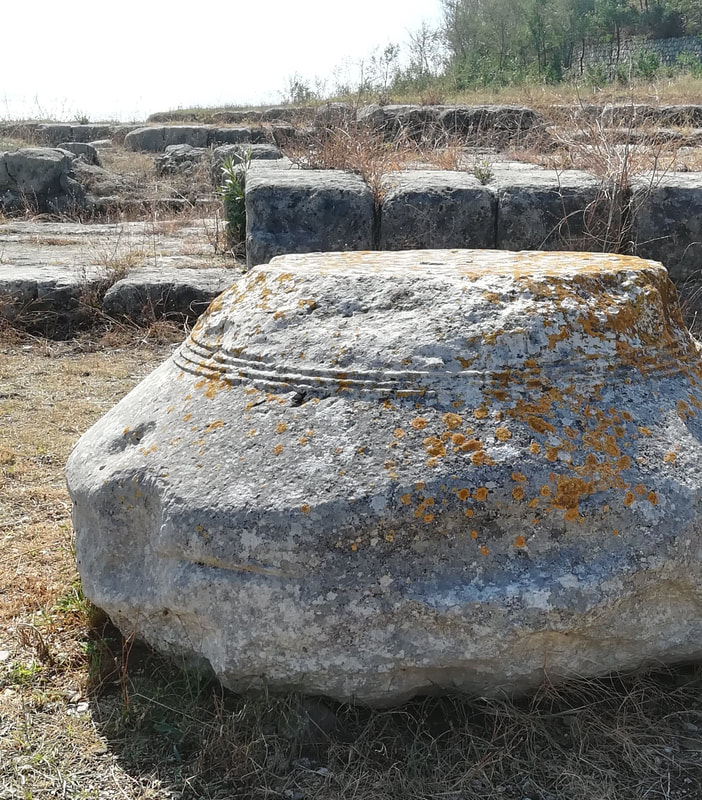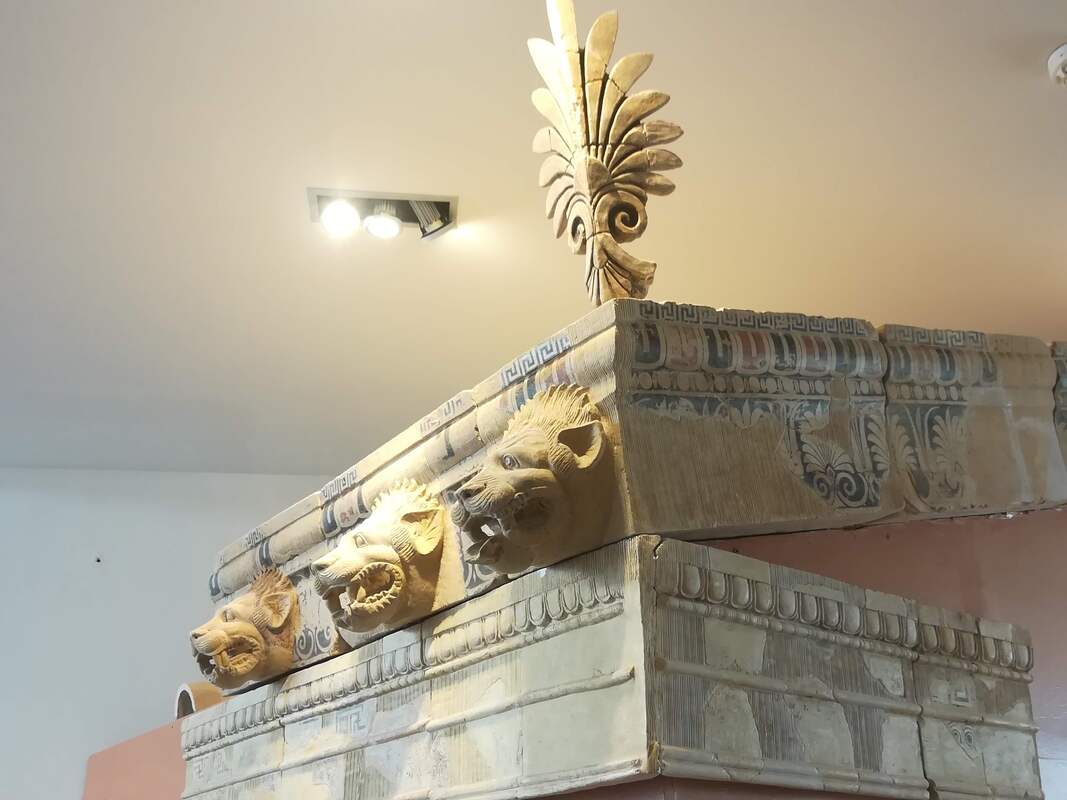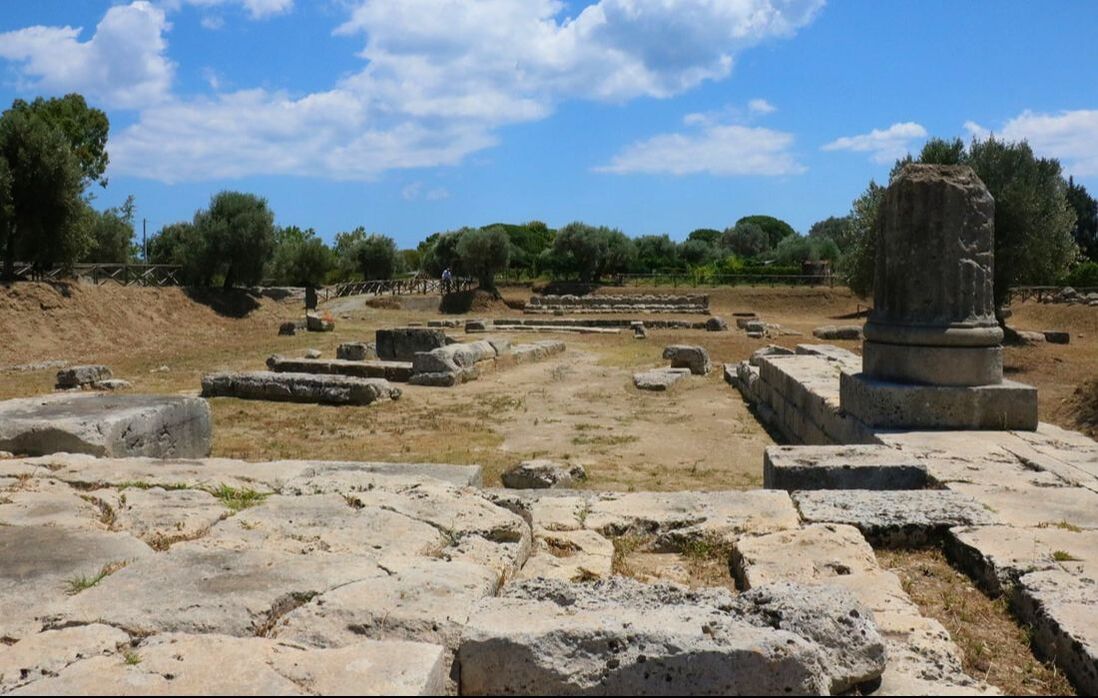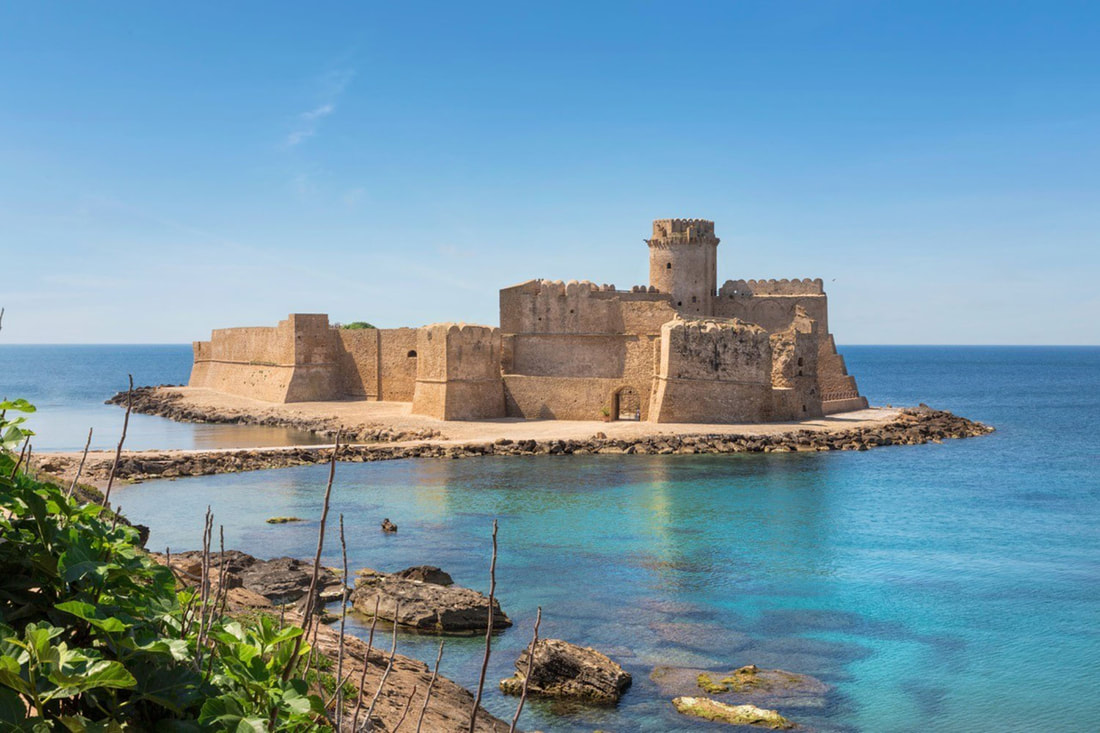|
The archaeological area of the ancient Greek city of Kaulon (or rather Kaulonia) lies near Punta Stilo, in the territory of the municipality of Monasterace Marina, along the Ionian coast of the province of Reggio Calabria. It is made up of both the Archaeological Park with a nice little Museum and the Archaeological Underwater Area in the sea section in front of the Park, where it’s possible to dive to see the underwater Archaeological Site of Kaulonia.
Over the centuries, due to a progressive phenomenon of coastal erosion and bradyseism, there has been a profound change in the coastline, which is backward compared to the age of the Greek colony. According to recent geo-archaeological studies, it appears that the coastline in front of the Kaulonia city, in the Greek age, was about 300 m further to the east than the present, as well as being characterised by a slightly arched shape. This wide area, time ago on the surface, is currently in the range of 7.5 m to 5 m deep and is characterised by the presence of many architectural elements, completed or semi-finished. These are pieces of columns (parts of the stem) and bases of grooved ionic columns, squared blocks of various sizes, rough hollow blocks and mooring bits. This important underwater site, made up of more than 200 finds, has been interpreted as an area of work of architectural elements or as a temple under construction, not completed for reasons still unclear. About the columns age, thanks to stylistic comparisons, it is probably set between 480 and 470 BC. The first excavations were undertaken at the beginning of the twentieth century and supervised by Archaeologist Paolo Orsi. They explored the sacred area, the Doric temple and part of the walls, then in the 1950s topographic and urban studies were conducted by Schmiedt and Chevallier. The excavation of the House of the Dragon is attributed to Alfonso De Franciscis, following his researches there were others investigating the temple, the walls and one of the residential areas. The archaeological investigations of the Ancient town of Kaulon started again only in the 1980s, thanks to the efforts of the Archaeological Superintendence of Calabria in collaboration with the national scholastic system and other institutions, both Italian and foreign. The researches made in the last decades studied almost exclusively the side of the town that oversees the sea: the temple area is being studied by the University of Pisa and the Scuola Normale Superiore; the vast complex of the Casa Matta is being investigated by the Archaeological Superintendence of Calabria with the contribution of the Mediterranean University of Reggio Calabria and the University of Calabria; while the University of Florence has been investigating the northern part of the ancient residential area, known as San Marco, since 2003. A path running parallel to the coastline, mimicking one of the main streets of the ancient city of Kaulon, allows visitors to observe the ruins of the residential area with its regular structure and its houses, preserved at the level of the foundations, starting from the buildings discovered in the area called San Marco, inhabited since the mid eight century B.C. Here were discovered some archaic structures to whose other buildings were superimposed, the “Casa del Personaggio Grottesco” (i.e. House of the Grotesque Character) built in the classical period and then a Hellenic period house on top of it. Continuing along the path, you get to the so-called Casa Matta (Crazy House), where they brought to light a luxury mansion that served different purposes in the course of time. In the same area you can see the ruins of a thermal complex, the so-called Thermal Baths of Nannon, boasting one of the most important and big mosaics of the Magna Graecia, the mosaic with dragons, dolphins and hippocampuses. In the last section of the itinerary you can see the sacred area with the Doric temple of which you can distinguish the base, the altar, the stairs and other structures of sacred character. Going back, a little road takes you to one of the most luxurious mansions of the ancient Kaulon, the House of the Dragon, where the mosaic now displayed in the museum was found. An underway located on the opposite side from the first will now lead you to a residential area at the feet of the hill of Punta Stilo’s lighthouse. The Archaeological Park also includes a wide underwater archaeological area, extending from the Doric temple to the Assi torrent, which is now submerged and under protection, and it coincides with a Hellenic period complex for the manufacturing of stone. Attractions
The healing potential of the thermal waters, known as "Ancient Waters," were known since ancient times, as they were used by the ancient city of Locri Epizephiri. The ancient Locrians sent the waters in their city through an aqueduct built along the bank of the stream of Gerace.
The millenarian history of Locri Epizephyrii (in Greek, Λοκροί Επιζεφύριοι) begins between the VIII and the VII century B.C. with the arrival, on the shores of southern Calabria, of a group of settlers from Locris, a poor region of the ancient Greece. From that moment onward, the history of the city develops in the course of the ages and it is studded by many meaningful events: from the magnificence of the archaic age and the alliance with Syracuse to the difficult impact with the Roman world; from the new positive dimension of Municipium to the unavoidable decline that will carry the city to drag itself on until the VII and the VIII century AD, when some environmental problems (lack of resources and spreading of malaria) added to the increasingly violence of Arab raids, pushed the last inhabitants of the zone to take shelter on the near mountains and, from then on, to contribute to the development of a new city: Gerace. The polis of Locri Epizephyrii was ruled following a typical Greek model. A strict conservative aristocracy exercised the power through the "one-thousand assembly", which was probably composed by all the citizens in charge of full political rights; also the population was divided in three tribes and thirty-six phratries. Between the VII and the VI century BC the development of the polis was well underway; the city flourished with a strict and organized urban plan, and its sanctuaries with their cults were already well recognized almost everywhere in the Greek world. The internal situation was, as it has been already pointed out, ideal to start planning an expansion of the control over the territory around the city, even with the creation of some sub-colonies. That was necessary because, more than the need of control over a larger portion of territory, there was the risk that the great demographic increase of that age could harm the social equilibrium reached by the polis. Therefore, probably during the end of the VII century BC, Medma (the modern Rosarno) and Hipponion (the modern Vibo Valentia) were founded on the Tyrrhenian coast. By this time, with the foundation of these two sub-colonies, Locri Epizephyrii took the control of a large part of territory, spreading from the Ionian to the Tyrrhenian coasts and embracing the mountains between the two seas; this expansion created the conditions for the historical clashes against Kroton and Rhegion, cities which began to see in Locri Epizephyrii a dangerous problem for their future expansion. Attractions
The cruise which takes place along the coast of Calabria is thematically dedicated to the discovery of some of the most important colonies of Magna Graecia. Following the same route that more than 2500 years ago followed the ancient settlers who came from Greece, it will be possible to visit Crotone, Caulonia, Locri, Reggio Calabria and also a series of other sites of historical and cultural interest. The cruise wants to be a tribute to the intimate and complex relationship that the Magna Graecia civilization had from the beginning with the sea and from which it drew strength and prosperity.
7day itinerary - On the Ionian Calabria
DAY 1 - REGGIO CALABRIA
Welcome meeting in Reggio Calabria Museum Hall; general project and cruise presentation Video Presentation about the visit in Reggio Calabria; visit in Archaeological Museum Lunch and walk along the promenade and city centre Check-in, accommodation on board Departure for Scilla town Departure for Roccella Ionica port. Arrive during the night DAY 2 - ROCCELLA IONICA (LOCRI EPIZEPHYRII) Briefing and Video presentation on Locri Epizephyrii Transfer by car to Locri. Visit of Archaeological Park and Museum Lunch in Locri in a picturesque tavern Transfer by car to Gerace, sightseeing of the old village Return to Roccella Dinner in a traditional tavern & night out. Return on board DAY 3 – ROCCELLA IONICA (KAULONIA) Departure from Roccella to Monasterace Port Video presentation about Kaulon Arrive in Punta Stilo, ARA diving or snorkeling in Capo Cocinto underwater site Lunch on board Transfer on land by tender and visit in Kaulon archaeological Museum and Temple Transfer by car to Stilo village and visit at the “Cattolica” church Return on board and coming back to Roccella Dinner in restaurant & night out. Return on board DAY 4 – SAILING Departure by boat from Roccella towards Le Castella Video about pottery and discussion of the following activity. Microplastics activity Video Presentation with general information about Magna Graecia Launch on board Video about pottery and discussion of the following activity. Pottery activity Arrive into Le Castella port Dinner in a local restaurant & night out. Return on board DAY 5 - LE CASTELLA Sail to Bengala shipwreck / ROV and sonar activity (with optional diving) Lunch on board Visit to the “Shipwreck of the Cannons” in Capo Bianco area (ARA diving or snorkeling) Coming back to Le Castella Visit to Ancient Greek Columns Quarries and Aragonese Castle Dinner in a restaurant & night out. Return on board 6 DAY - LE CASTELLA AND CROTONE Departure from the Le Castella port Arrive at Capo Cimiti and visit to the Columns shipwreck (ARA diving or snorkeling) Sailing to Punta Scifo D shipwreck: Video presentation and diving and virtual reality activity Lunch on board and Video presentation about Capo Colonna Arrive in Crotone and transfer by car to Capo Colonna Archaeological Park and Museum Special Dinner in Crotone on the traces of the ancient Greek food & night out. Return on board DAY 7 - CROTONE OPTION 1 Video Presentation about Crotone Visit at the Archaeological Museum and walk along old centre and marketplace Discussion of the trip (evaluation form, questionnaire) Lunch in a restaurant OPTION 2 Pesentation about Crotone Visit at the Archaeological Museum and walk along old centre and marketplace Lunch in a restaurant Visit at “Pitagora Museum and Gardens” and walk along promenade Discussion of the trip (evaluation form, questionnaire) Transfer by car to Cirò area for dinner and wine experience |
